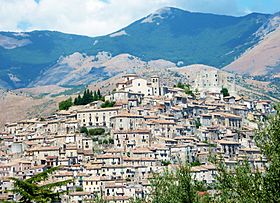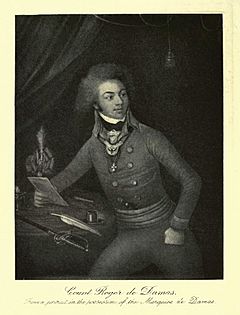Battle of Campo Tenese facts for kids
Quick facts for kids Battle of Campo Tenese |
|||||||
|---|---|---|---|---|---|---|---|
| Part of the War of the Third Coalition | |||||||
 Campotenese is located in the Morano Calabro municipality. The photo of Morano Calabro shows nearby mountainous terrain. |
|||||||
|
|||||||
| Belligerents | |||||||
| Kingdom of Naples Kingdom of Sicily |
|||||||
| Commanders and leaders | |||||||
| Jean Reynier | Roger de Damas | ||||||
| Strength | |||||||
| 10,000 | 14,000 | ||||||
| Casualties and losses | |||||||
| unknown but light | 1,000 killed & wounded 2,000 captured 8,000–9,000 deserted guns & baggage captured Total: 11,000-12,000 |
||||||
The Battle of Campo Tenese happened on March 9, 1806. It was a fight between the French army, led by Jean Reynier, and the Neapolitan army, led by Roger de Damas. The battle took place near Campotenese, a small mountain village in Calabria, Italy. This battle was part of the War of the Third Coalition, which was a bigger conflict during the Napoleonic Wars. The French won a quick victory, causing many losses for the Neapolitans.
After Napoleon won a big battle at Battle of Austerlitz, he decided that the Bourbon family should no longer rule southern Italy. This was because King Ferdinand IV of Naples had allied himself with countries fighting against Napoleon. In February 1806, French armies moved into Naples. The Neapolitan army split into two groups and retreated. At Campo Tenese, General Damas tried to stop the French. He wanted to give the other part of his army time to join him.
After this defeat, many Neapolitan soldiers left the army. Only a few thousand were saved by the British Royal Navy and taken to Sicily. However, the fighting was not over. The French still faced challenges like the siege of Gaeta, a British victory at Maida, and a tough rebellion in Calabria.
Why the Battle Happened
In early 1806, French Emperor Napoleon was getting ready to protect his lands in Italy. He had many soldiers ready for battle. King Ferdinand of Naples was worried. He made a deal with Napoleon to stay neutral during the War of the Third Coalition.
But as soon as some French troops moved away, King Ferdinand and Queen Maria Carolina broke their promise. They invited British and Russian soldiers to land in their kingdom. Napoleon felt tricked. British and Russian forces arrived in Naples in November 1805. However, Napoleon won a huge victory at the Battle of Austerlitz in December 1805. This caused the Third Coalition, the group of countries fighting Napoleon, to fall apart. So, the British and Russian troops left Naples by mid-January. This left King Ferdinand alone to face Napoleon's anger. Napoleon decided to conquer the Kingdom of Naples and give its crown to his brother, Joseph Bonaparte.
In January 1806, the French army in Naples was put under the command of Marshal André Masséna. Joseph Bonaparte was the official leader. The army was divided into three main groups. French troops crossed the border into Naples on February 8, 1806. They met no resistance, which caused panic at the royal court. The Queen left Naples on February 11, and the King had already left in January.
Masséna's main group quickly reached Gaeta, a strong fortress north of Naples. The commander there refused to surrender. So, Masséna left one group of soldiers to surround Gaeta. He then moved on to Naples with another group. On February 14, Masséna took control of Naples. Joseph Bonaparte entered the city the next day. Jean Reynier's group also arrived in Naples. Joseph then took charge of the army. He ordered Reynier to march quickly towards the Strait of Messina.
The Battle at Campotenese
The Neapolitan army was split into two parts. One part was led by Roger de Damas, and the other by Marshal Rosenheim. Reynier, with about 10,000 French soldiers, left Naples and moved south. The Neapolitan groups retreated as the French advanced. Damas' group had between 6,000 and 7,000 regular soldiers, plus local fighters. The two Neapolitan commanders hoped to join their forces together. Damas decided to hold a strong position in the mountains. He wanted to block the French until the other Neapolitan group could arrive.
On March 6, Reynier's advance troops found Damas' rear guard. The French easily defeated them, causing 300 casualties and capturing four cannons. Reynier's scouts found Damas' main position on March 8. The French general planned to attack the next day.
In March 1806, Reynier's force had two divisions. One was his own French division, and the other was led by General Verdier. Verdier's division included the 1st Polish Legion and a Swiss regiment. The French also had cannons and cavalry units.
Damas' Neapolitan force had about 14,000 soldiers. However, only half of them were regular, trained soldiers. His troops took up a strong position near Campotenese. They were protected by earth walls. The Neapolitans spread out across a valley about 1,500 meters wide. Both sides of their position were protected by mountains. The pass behind them was a weak point, as it could make retreating difficult. Damas placed nine battalions in his front line. They defended three cannon forts. He also had cavalry support and a second line of troops. But he did not guard the mountains on either side of his position.
Reynier's troops started moving on the morning of March 9. A strong wind blew snow into the eyes of the Neapolitan soldiers. Reynier sent one group of light infantry to go around the Neapolitan right side. They climbed along the cliffs and appeared behind the Neapolitan lines. This caused a lot of confusion among the Neapolitans. At the same time, General Louis Fursy Henri Compère led a direct attack on the Neapolitan front line. After a short fight, Compère's men charged forward and captured one of the forts.
With attacks from both the front and the rear, the Neapolitan line broke. The soldiers panicked and tried to escape through the valley exit. Soon, the pass was jammed with fleeing soldiers. The French captured 2,000 prisoners, including two Neapolitan generals. In total, the Neapolitans lost about 3,000 soldiers. Their cannons and supplies were also captured. The French had very few losses. This battle effectively destroyed the Neapolitan army as a fighting force.
What Happened Next
That evening, Reynier's troops camped at the village of Morano Calabro. By March 13, Reynier had marched 60 kilometers to Cosenza. The French reached Reggio Calabria on the Strait of Messina a week later. Prince Francis, who was with the other Neapolitan group, barely escaped. As Reynier chased Damas' defeated group, other French generals pursued the group led by Marshal Rosenheim and the prince. During the retreat, the Neapolitan army fell apart. Only about 2,000 or 3,000 regular soldiers from both groups managed to escape by ship to Messina in Sicily. Most of the local fighters went home, and many regular soldiers simply left the army. Before leaving for Sicily, Prince Francis encouraged the local fighters to form small groups to fight the French.
In 1806, much of Calabria was a difficult place. Earthquakes in 1783 had caused a lot of damage. Many towns were still in ruins. The people of Calabria were tough and independent. French soldiers often took things from the local people. French officials also sometimes acted unfairly. This quickly led to a rebellion by the proud Calabrians. However, people in the bigger towns often preferred the French over their old Neapolitan government.
The revolt grew after certain events. For example, at Scigliano, the French left a small group of 50 soldiers. The French commanders often responded to such events by attacking, robbing, and burning down villages. This led to a terrible cycle of violence. The new King Joseph tried to be fair. He ordered French soldiers to be punished for crimes and officials to be tried for corruption. Still, the Calabrian rebellion quickly got out of control. The siege of Gaeta kept the French busy for months. Also, the Battle of Maida on July 4 seriously threatened French control of Calabria.



